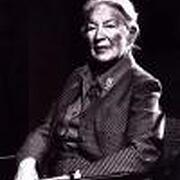C. V. Wedgwood (1910–1997)
Autor(a) de The Thirty Years War
About the Author
Image credit: auden-stanford.edu
Séries
Obras de C. V. Wedgwood
The Spoils of Time: A History of the World From Earliest Times to the Sixteenth Century (1984) 107 cópias
Oliver Cromwell and the Elizabethan Inheritance (Neale Lecture) by Wedgwood C. V. (1970-12-08) Paperback (1600) 2 cópias
Rare Coffin for King Charles: Trial & Execution of Charles I (of England) Wedgwood [Hardcover] unknown 1 exemplar(es)
Oliver Cromwell 1 exemplar(es)
Comedy in the Reign of Charles I 1 exemplar(es)
The 'time and Tide' Crossword Book or Curlew and Sardonyx Crosswords from "Time and Tide" (1954) 1 exemplar(es)
Literature and the historian 1 exemplar(es)
The English Civil War in perspective 1 exemplar(es)
Civil war battlefields 1642-46 — Autor — 1 exemplar(es)
The Common Man in the Great Civil War 1 exemplar(es)
Associated Works
Etiquetado
Conhecimento Comum
- Nome de batismo
- Wedgwood, Cicely Veronica
- Outros nomes
- Wedgwood, Veronica
- Data de nascimento
- 1910-07-20
- Data de falecimento
- 1997-03-09
- Local de enterro
- Alciston Parish Church, Alciston, East Sussex, England, UK
- Sexo
- female
- Nacionalidade
- UK
- Local de nascimento
- Stocksfield, Northumberland, England, UK
- Local de falecimento
- London, England, UK
- Causa da morte
- Alzheimer's disease
- Locais de residência
- London, England, UK
- Educação
- Lady Margaret Hall, Oxford University (BA|1931)
Norland Place School, London - Ocupação
- historian
lecturer
translator
broadcaster
biographer - Relacionamentos
- Wedgwood, Josiah Clement (uncle)
Vaughan Williams, Ralph (father's cousin)
Hope-Wallace, Jacqueline (partner) - Organizações
- Institute for Advanced Study, Princeton, New Jersey, USA
PEN Club (president)
Society of Authors
Somerville College, Oxford
University College London - Premiações
- Order of Merit (1969)
Dame Commander of the Order of the British Empire (1968)
Commander of the Order of the British Empire (1956)
Goethe Medal (1958)
Order of Orange-Nassau (1946)
American Academy of Arts and Letters (1966) (mostrar todas 12)
Fellow, Royal Historical Society
Fellow, British Academy (1975)
James Tait Black Memorial Prize (1944)
Foreign Honorary Member, American Academy of Arts and Sciences (1973)
Fellow, American Philosophical Society (1969)
Fellow, Royal Society of Literature (1947) - Pequena biografia
- C.V. "Veronica" Wedgwood was an English historian who specialized in 16th and 17th century European histories, especially the English Civil War. She took a First in Modern History at Oxford University. The Independent called her the most distinguished woman historian of her time. Her acclaimed biographies include those of Oliver Cromwell, Thomas Wentworth, Earl of Strafford, William the Silent, and Cardinal Richelieu. She was a direct descendant of the famous 18th-century potter Josiah Wedgwood. Among her many volunteer roles and honors, she served as a trustee of the National Gallery and president of the Society of Authors as well as president of the International PEN Club. She was also the author of two translations: Charles V by Carl Brandi in 1939, and Elias Canetti's Die Blendung, as Auto-da-Fé, in 1946.
Membros
Resenhas
Listas
Prêmios
You May Also Like
Associated Authors
Estatísticas
- Obras
- 36
- Also by
- 6
- Membros
- 4,035
- Popularidade
- #6,236
- Avaliação
- 4.0
- Resenhas
- 40
- ISBNs
- 98
- Idiomas
- 6
- Favorito
- 7
















Just like the war itself, I began to flag around the 18 year mark and ended up limping along for awhile before I could properly rally.
One of the best parts of this book is the author's analyses, which were insightful and compelling.
One of the biggest hurdles was keeping track of all the names, but I discovered the X-ray feature on the Kindle lets you long-press a name and get a recap of who they are in the context of the book - extraordinarily helpful, and I used it constantly.
Overall, a very good read.… (mais)